Making Voices Sound Normal Again After Removing Background Noise Audacity
In terminal calendar week'due south blog mail service we gave y'all some tips to help you get higher quality vocal recordings.
That advice was meant to be put into use during the preparation phase, long before you press the record button.
This week'southward article is all nigh post-production, meaning the things that you can do to raise your audio after information technology'southward already been recorded.
More specifically, we're going to teach y'all how to utilise Brazenness - a professional sound editing tool - in order to clean upwardly your recordings and create professional sounding voice overs for your videos.
Since a proficient setup is going to make post-production a lot easier, we highly recommend that you follow the steps in the previous article outset in order to become the all-time results.
Choosing the Audio Recording Software
Those of yous that have used Flixier earlier probably know that our online video editor tin can exist used to tape audio through your computer'southward microphone. Nosotros've actually updated the entire recording component of Flixier to let yous to record your figurer screen and webcam too, pregnant that you can at present employ Flixier to tape entire video tutorials or Permit's Play videos straight from your web browser!

Brand certain your microphone shows up as a recording device and that your headphones/speakers (depending on what you utilize) are selected as the playback device.
This manner you'll exist able to record your phonation and listen back to your audio during editing.
Next up are the recording and playback controls:
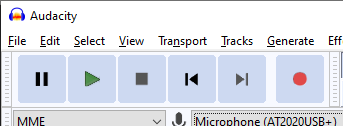
These volition look familiar to anyone who has always used a music histrion earlier.
The crimson push makes Audacity kickoff recording, while the greyness square stops it.
You use the play and pause buttons to control the playback when you're reviewing your audio tracks, merely like y'all would do with the video preview in Flixier!
These two sliders control the gain (microphone icon) and playback volume (speakers icon) respectively:

If yous read our previous slice, yous already know that setting your microphone gain properly is an essential part of recording.
If your microphone doesn't accept a physical gain dial, then you can modify it using the slider here in Audacity.
At the summit is a listing of drop-downwards menus.

The File card is where you go to salve your projects and import and export audio files.
Have a skillful look at the Effect menu, because that's where we're going to exist spending all of our time when editing our voice over.
Now that you've become acquainted with the basic elements of Audacity's interface, it's fourth dimension to go to work!
1. Record your audio into Audacity
The starting time step is pretty straightforward.
Just hit the scarlet button to start recording your voice over!
Before yous start talking, withal, let the microphone tape a few seconds of "silence". This is also known as "room tone" and it will come up in handy later when nosotros use Noise Reduction to become rid of all the background racket.
Y'all'll also notice that a timeline appears on your screen, displaying the waveform of your audio and updating in existent time equally you speak.
2. Utilize Noise Reduction
At present that you've finished recording your voiceover, your timeline should look something like this:
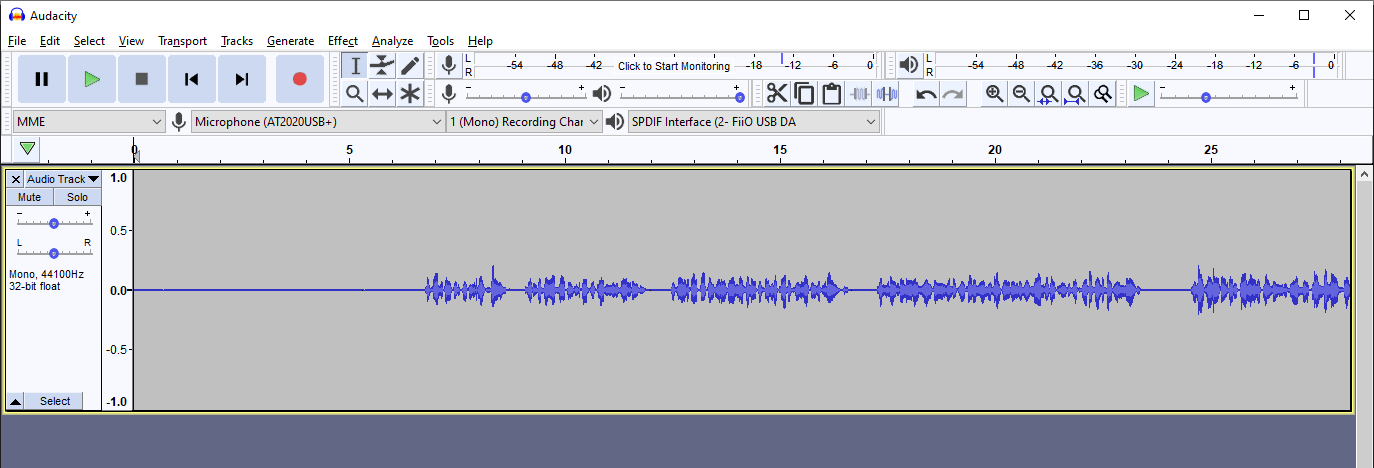
Yous can zoom the in and out on the Timeline by belongings down the Command key and using your mouse bicycle.
Similarly, y'all can select things on the timeline by clicking and dragging with your left mouse button.

If you listen dorsum to your recording, you'll probably notice some background noise. We're going to apply Audacity to remove information technology. Here'south how:
1. Select the "tranquility" segment at the start of the track. The one that's all background dissonance, with no talking.

two. Then, go to the Outcome card at the pinnacle and select Dissonance Reduction.
A window will pop up with a couple sliders. In the screenshot below, you tin can meet the settings that I'm using, just the default ones will do just fine.

iii. Before it tin apply the Dissonance Reduction, Audacity needs to know what the "dissonance" itself sounds like. This is why we selected the background noise portion of your audio. Click on Go Noise Contour.
4. Now that Audacity has the racket profile, select all of your sound using Ctrl + A and then go back to the Effect carte and select Repeat Noise Reduction. Alternatively, pressing Ctrl + R repeats the final result automatically.
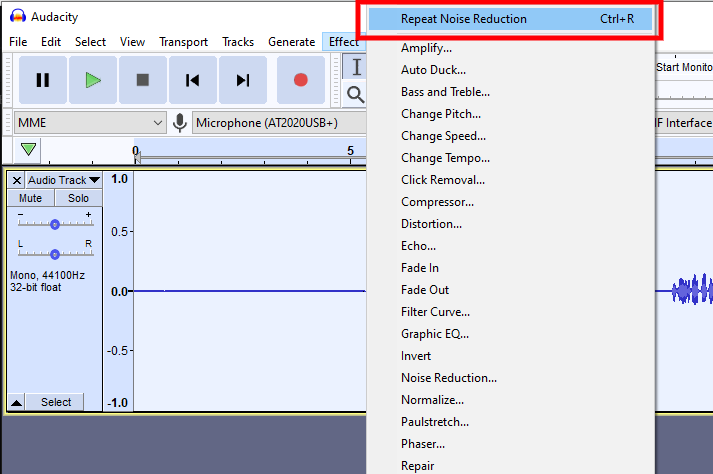
That's it! All of the background noise should now be removed.
If there'southward all the same noise, you lot can attempt applying the filter over again, but watch out: using the noise reduction effect too many times will reduce your sound quality and make your voice sound tinny and robotic, so utilise your own discretion.
3. Normalize to 0 dB
In our previous guide, we mentioned that yous should prepare your gain lower than 100% in order to prevent clipping.
If you followed our advice, yous will notice that your newly recorded track is a picayune quiet. This next pace will fix that.
i. Select your entire rails again using Ctrl + A.
2. Go dorsum to the Event menu and click on Normalize.
three. When this carte pops up, copy the settings that you come across in the screenshot and click okay.
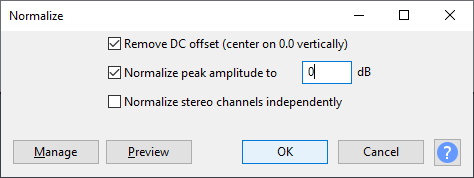
We used the Normalize option to amplify our audio and make it the loudest it can be without distorting it. Y'all likely noticed the soundwave getting a lot thicker on the timeline.

If you're wearing headphones, you might want to plough the volume down a little before previewing the changes!
4. Compress
At present that your audio is loud enough, it's fourth dimension to compress information technology!
In layman's terms, the Compressor is going to make the loud parts a little quieter and the quiet parts a little louder.
That might sound stupid, but trust is, it's going to make everything sound crisp and you'll be a lot easier to understand.
In society to apply the compression upshot, follow the same steps every bit earlier: select the entire runway with Ctrl + A and and so click on Compressor in the Outcome card.
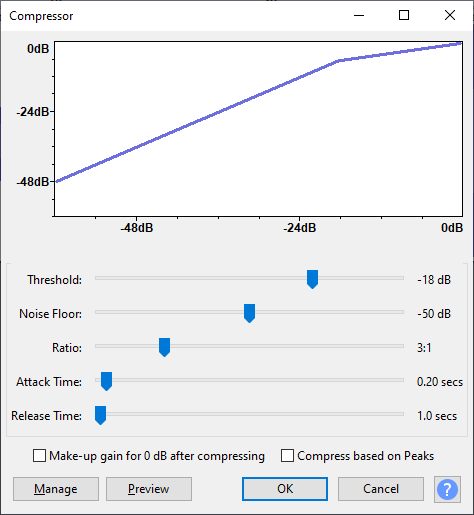
There'south a lot of sliders to play with when information technology comes to compression.
Nosotros recommend that y'all play information technology condom and copy the settings yous see in the screenshot.
If you lot experience like your audio sounds a lilliputian odd afterwards previewing information technology, you can lower the ratio from 3:1 to 2:1.
Click OK and listen to your audio again.
Information technology will sound a lot crisper, simply you'll too notice that information technology went dorsum to being a petty quiet.
Don't worry, we're going to fix that presently plenty!
5. Add some EQ
This side by side footstep is going to be very subjective, since it depends a lot on your voice and microphone.
When yous listen back to your recording, you may notice that your vox sounds a lilliputian off. It might be a little as well bassy or (as is ofttimes my case) a little likewise nasal and grating.
Luckily, we can hands fix that by adjusting the depression, mid or high stop a lilliputian in Audacity.
To do this, you need to select the unabridged track again with Ctrl + A, head to the Issue card and choose Filter Curve.
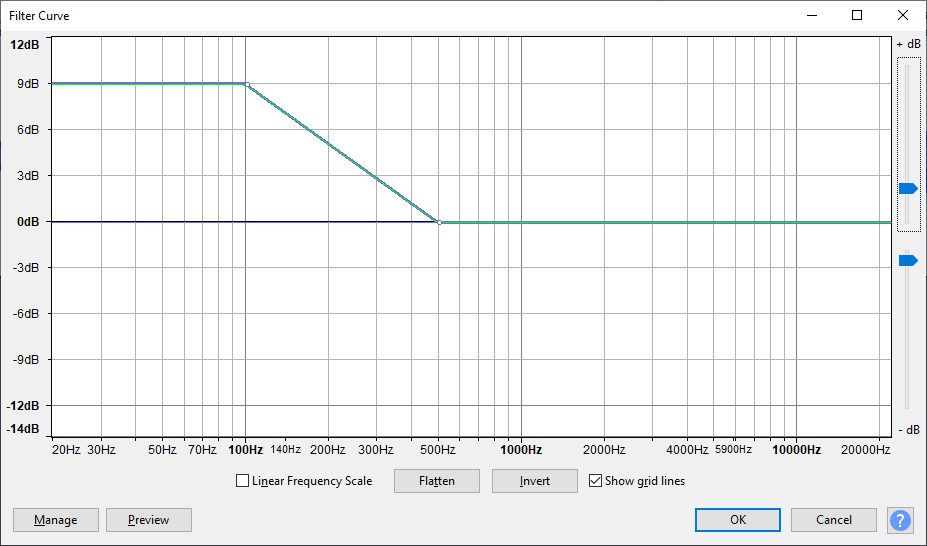
Feel free to play effectually with the curve here and adjust it to your liking.
Yous tin ever press the Preview button in the bottom left to listen to the changes before yous apply them.
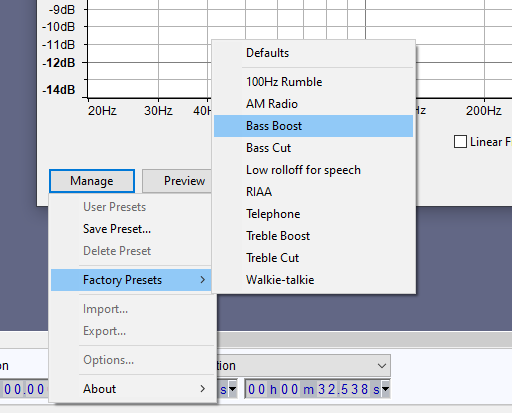
If you're not certain what you're doing, you lot should become to Manage, then Factory Presets and choose i of the presets there.
When I edit my videos I like to apply the Bass Boost manufacturing plant preset, since my vocalization is a little defective on the low end.
Once you've called your blaster settings, click on OK and Audacity volition apply them to your track!
6. Normalize (once again) to -3 dB
The terminal step in the process is bringing your audio back to a loud plenty book.
We're going to apply Normalize again in social club to do that, just this time nosotros're going to set the elevation amplitude to -iii.0 dB.
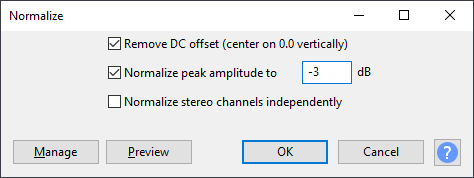
This will effect in audio that's still loud, just give you a little room to play with in example y'all demand to amplify it more in the futurity.
Using a Noise Gate to remove breathing sounds
If yous mind to the final recording again, you might take the displeasure of discovering that despite the noise reduction we applied in the first pace, you can yet hear yourself breathing loudly between sentences.
Not everyone will take this problem, but if you exercise run into it, there is a way to fix it!
Installing Nyquist'southward Noise Gate plug-in
In order to do that, though, yous'll first need to install a plug-in for Audacity. Don't worry, we'll walk yous through the process:
- Download the plug-in from this website. You should end up with a file called Noisegate.ny
- Copy the file.
- Navigate to your Audacity install binder, go to Plug-Ins and paste Noisegate.ny file into that folder.
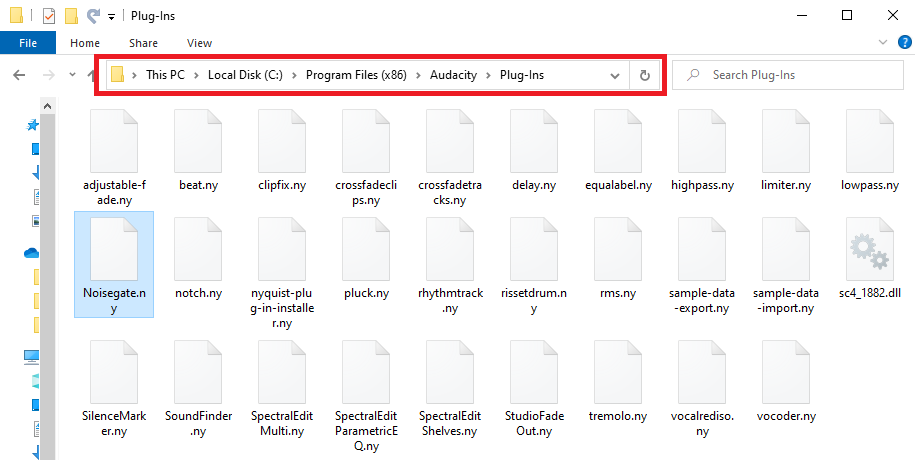
By default, the install path should exist C:\Program Files (x86)\Audacity\Plug-Ins (if yous're using Windows)
4. Open up up Brazenness, go to the Effect tab and click on Add / Remove Plug-Ins
5. Look for the plug-in called Racket Gate. Select it and click on Enable.
At present that the plug-in is installed, let'due south get to work on getting rid of the unwanted breathing sounds:
First, click on this little pointer icon on the Timeline. From the drop-downwards card, select Waveform (dB).

Now zoom in on an audio snippet where in that location is an aural breath. Check to see what dB levels the jiff reaches past looking at the measurements on the left side of the timeline.
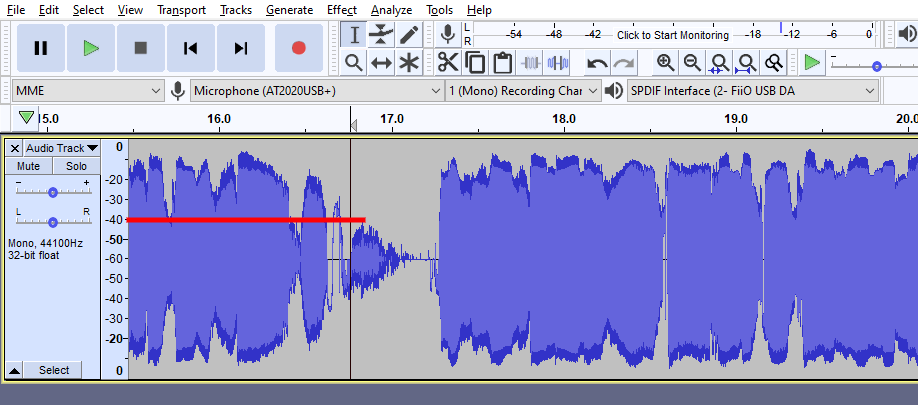
In my example, my breathing reaches around -40 dB.
Now, select your audio runway, go to the Effect tab and click on Noise Gate. This menu will pop up:
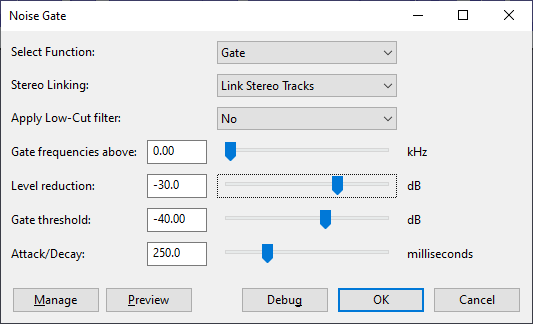
A dissonance gate analyzes the volume of all of the sounds in your recording. Any sound that doesn't cross a sure volume threshold (like a loud inhale) gets muted!
In our case, we want to set the Gate Threshold to -forty dB.
Since my voice is significantly louder than -40 dB, the Racket Gate will leave it alone. My animate sounds however are under -40 dB, and so their volume will be reduced.
Use the Level reduction slider to cull how much you want the volume of the breathing to be reduced. You can set information technology to something like -xl to make it completely placidity, or something like -20 to go far merely barely audible (since no animate sounds at all can sound a trivial unnatural).
Exit the other settings at their default value.
Click OK and your Noise Gate will be practical, resulting in a crisp voice over that doesn't have whatsoever loud inhale or exhale noises.
NOTE: Try not to set the Gate Threshold to anything to a higher place -35, since that might finish up muffling some of your speech. Go along in mind that in lodge for the Noise Gate to be constructive, your speaking voice needs to be significantly louder than the animate noises.
That's it! Your phonation over should at present sound significantly improve than it did simply 5 minutes agone!
Y'all can save your Brazenness project past going to the File carte du jour and clicking on Salve Project.
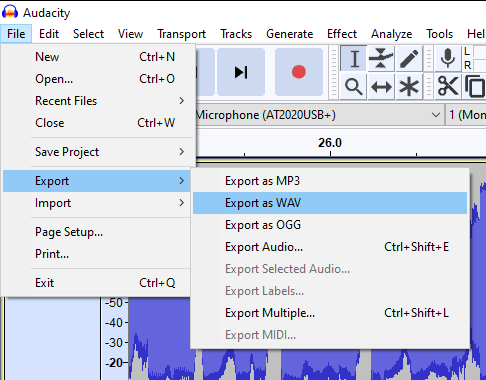
If you want to end up with an actual sound file that you tin can import into your video editing software, choose the Export option.
I usually cull to export my files in the .WAV format in club to ensure maximum quality.
After your audio file has been successfully exported, y'all can import it into Flixier and starting time editing your video!
Closing Words
Thank you lot for making information technology this far! We know Audacity isn't the well-nigh user friendly software, but we promise this guide managed to help you navigate it!
Skillful luck making videos and make certain to keep an middle on our web log or subscribe to our YouTube aqueduct for more video editing guides!
Related Posts
- vii tips that will brand your microphone sound meliorate when recording
- How to effectively sound in your video
- How to go amazing audio for your videos
- How to create bully instructional videos in 6 easy steps
- 25 tips that will help you abound and get more views on YouTube
Source: https://flixier.com/blog/how-to-make-your-voice-recordings-sound-better-in-audacity
0 Response to "Making Voices Sound Normal Again After Removing Background Noise Audacity"
Post a Comment